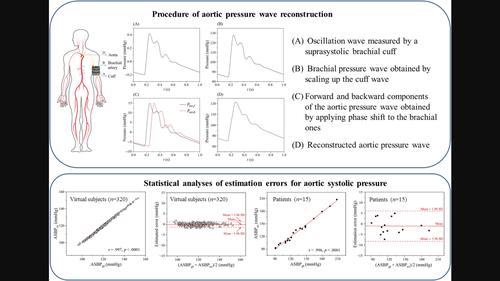当前位置:
X-MOL 学术
›
Int. J. Numer. Method. Biomed. Eng.
›
论文详情
Our official English website, www.x-mol.net, welcomes your feedback! (Note: you will need to create a separate account there.)
Optimization and validation of a suprasystolic brachial cuff-based method for noninvasively estimating central aortic blood pressure
International Journal for Numerical Methods in Biomedical Engineering ( IF 2.1 ) Pub Date : 2024-01-28 , DOI: 10.1002/cnm.3806 Xujie Zhang 1 , Yue Wang 2 , Zhaofang Yin 2 , Fuyou Liang 1
International Journal for Numerical Methods in Biomedical Engineering ( IF 2.1 ) Pub Date : 2024-01-28 , DOI: 10.1002/cnm.3806 Xujie Zhang 1 , Yue Wang 2 , Zhaofang Yin 2 , Fuyou Liang 1
Affiliation

|
Clinical studies have extensively demonstrated that central aortic blood pressure (CABP) has greater clinical significance in comparison with peripheral blood pressure. Despite the existence of various techniques for noninvasively measuring CABP, the clinical applications of most techniques are hampered by the unsatisfactory accuracy or large variability in measurement errors. In this study, we proposed a new method for noninvasively estimating CABP with improved accuracy and reduced uncertain errors. The main idea was to optimize the estimation of the pulse wave transit time from the aorta to the occluded lumen of the brachial artery under a suprasystolic cuff by identifying and utilizing the characteristic information of the cuff oscillation wave, thereby improving the accuracy and stability of the CABP estimation algorithms under various physiological conditions. The method was firstly developed and verified based on large-scale virtual subject data (n = 800) generated by a computational model of the cardiovascular system coupled to a brachial cuff, and then validated with small-scale in vivo data (n = 34). The estimation errors for the aortic systolic pressure were −0.05 ± 0.63 mmHg in the test group of the virtual subjects and −1.09 ± 3.70 mmHg in the test group of the patients, both demonstrating a good performance. In particular, the estimation errors were found to be insensitive to variations in hemodynamic conditions and cardiovascular properties, manifesting the high robustness of the method. The method may have promising clinical applicability, although further validation studies with larger-scale clinical data remain necessary.
中文翻译:

基于上收缩臂袖带的无创评估中心主动脉血压方法的优化和验证
临床研究广泛表明,与外周血压相比,中心主动脉血压(CABP)具有更大的临床意义。尽管存在多种无创测量 CABP 的技术,但大多数技术的临床应用都因测量误差的准确性不令人满意或变化较大而受到阻碍。在这项研究中,我们提出了一种无创估计 CABP 的新方法,该方法提高了准确性并减少了不确定性误差。主要思想是通过识别和利用袖带振荡波的特征信息,优化上收缩袖带下从主动脉到肱动脉闭塞管腔的脉搏波传播时间的估计,从而提高估计的准确性和稳定性。各种生理条件下的CABP估计算法。该方法首先基于与臂套耦合的心血管系统计算模型生成的大规模虚拟受试者数据(n = 800)进行开发和验证,然后用小规模体内数据(n = 34)进行验证。虚拟受试者测试组的主动脉收缩压估计误差为-0.05±0.63 mmHg,患者测试组的主动脉收缩压估计误差为-1.09±3.70 mmHg,均表现出良好的性能。特别是,我们发现估计误差对血流动力学条件和心血管特性的变化不敏感,这表明该方法具有很高的鲁棒性。该方法可能具有有希望的临床适用性,但仍需要使用更大规模的临床数据进行进一步的验证研究。
更新日期:2024-01-28
中文翻译:

基于上收缩臂袖带的无创评估中心主动脉血压方法的优化和验证
临床研究广泛表明,与外周血压相比,中心主动脉血压(CABP)具有更大的临床意义。尽管存在多种无创测量 CABP 的技术,但大多数技术的临床应用都因测量误差的准确性不令人满意或变化较大而受到阻碍。在这项研究中,我们提出了一种无创估计 CABP 的新方法,该方法提高了准确性并减少了不确定性误差。主要思想是通过识别和利用袖带振荡波的特征信息,优化上收缩袖带下从主动脉到肱动脉闭塞管腔的脉搏波传播时间的估计,从而提高估计的准确性和稳定性。各种生理条件下的CABP估计算法。该方法首先基于与臂套耦合的心血管系统计算模型生成的大规模虚拟受试者数据(n = 800)进行开发和验证,然后用小规模体内数据(n = 34)进行验证。虚拟受试者测试组的主动脉收缩压估计误差为-0.05±0.63 mmHg,患者测试组的主动脉收缩压估计误差为-1.09±3.70 mmHg,均表现出良好的性能。特别是,我们发现估计误差对血流动力学条件和心血管特性的变化不敏感,这表明该方法具有很高的鲁棒性。该方法可能具有有希望的临床适用性,但仍需要使用更大规模的临床数据进行进一步的验证研究。



























 京公网安备 11010802027423号
京公网安备 11010802027423号